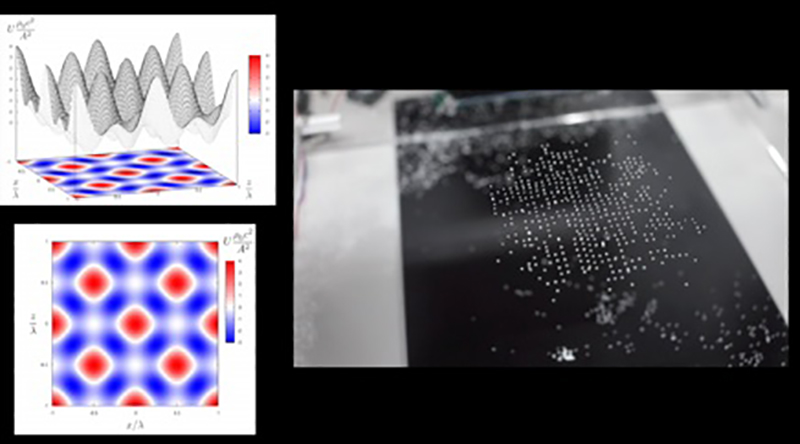
Pixie Dust is a 3D acoustic levitation technology using ultrasonic phased arrays. Although it is known that objects can be levitated by ultrasound, it is now possible to freely move the levitated objects, or to arrange them in an order different from the conventional setups, by controlling the distribution of ultrasound.
Lifting small parts without using a robot arm in a factory or transporting droplets such as medicines or lotions to a bottle, are potential applications. Moreover, this technology can also be applied to entertainment and advertisements, such as installing a video projection screen in air by arranging white particles in a 2D flat formation.
< Case >
■Case1
A projection screen can be created in air by arranging polystyrene particles to a 2D flat formation.

■Case2
Small parts can be individually conveyed. Moreover, as this is a contactless technology, it is possible to avoid contamination in pharmaceuticals and lotions.

< Theory >
■ Phased array
An ultrasonic phased array is a device in which each of hundreds of ultrasonic transducers can be separately pulsed at different timings. It is possible to generate a strong ultrasound only at a target position, by controlling these timings to manipulate the interference of the ultrasound waves.
In this technology, multiple ultrasonic phased arrays are used surrounding a target space. Overlap in the ultrasonic waves generated from each of these arrays creates a standing wave.
In conventional acoustic levitation technologies, objects are levitated using a single beam-shaped standing wave. In our technology, the acoustic potential field designed by a computer is reproduced using the ultrasonic phased arrays, making it possible to realize a variety of spatial distributions. The case of creating a projection screen in air, as in Case 1, is such an example.



■ International conference papers
[Journal] Yoichi Ochiai, Takayuki Hoshi, and Jun Rekimoto. 2014. Pixie dust: graphics generated by levitated and
animated objects in computational acoustic-potential field. ACM Trans. Graph. 33, 4, Article 85 (July 2014), 13 pages.DOI: https://doi.org/10.1145/2601097.2601118\
[Poster] Yoichi Ochiai, Takayuki Hoshi, and Jun Rekimoto. 2014. Pixie dust: graphics generated by levitated and animated objects in computational acoustic-potential field. In ACM SIGGRAPH 2014 Posters (SIGGRAPH '14). ACM, New York, NY, USA, Article 83, 1 pages. DOI: https://doi.org/10.1145/2614217.2614219\
[Demo] Yoichi Ochiai, Takayuki Hoshi, and Jun Rekimoto. 2014. Pixie dust: graphics generated by levitated and animated objects in computational acoustic-potential field. In ACM SIGGRAPH 2014 Emerging Technologies (SIGGRAPH '14). ACM, New York, NY, USA, Article 21, 1 pages. DOI: https://doi.org/10.1145/2614066.2614068